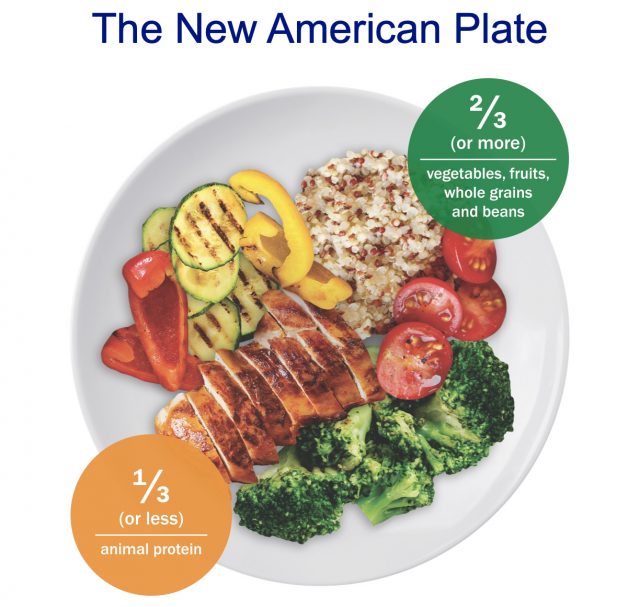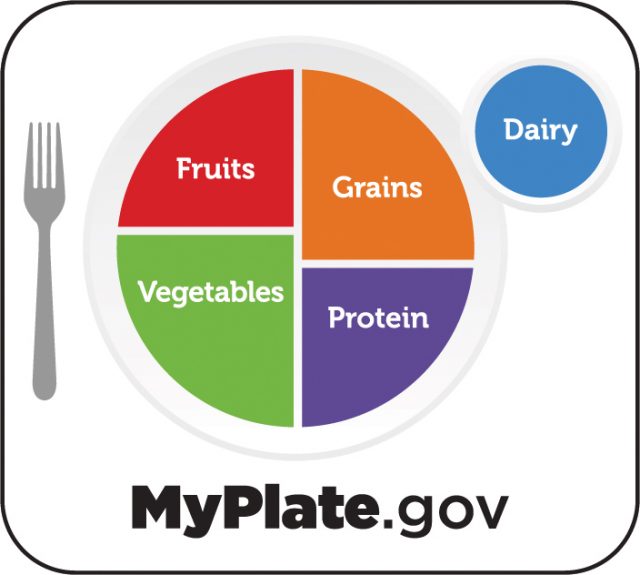With poor diet, obesity and diseases like cancer increasing the risk for poor outcomes from COVID-19, there has never been a more important time to be thoughtful about what we eat. But how do we know if we are making smart choices? It can be hard to cut through the misinformation and truly follow the science. That’s where evidence-based guidelines come in.
The Dietary Guidelines for Americans
As we previously wrote, the 2020-2025 Dietary Guidelines for Americans (DGA) were released in late 2020, and they will inform all federal food and nutrition policies, programs and communications from now until 2025. These guidelines were informed by the scientific report of a committee of independent experts appointed to review the evidence on pre-determined topics related to diet and health, and more than 100,000 public comments. AICR was thoroughly engaged throughout the DGA development process, submitting multiple comment letters to inform both the review of the evidence on topics related to diet, obesity, alcohol, and cancer, and the development of the DGA policy report based on this research.
Similarities Between the Dietary Guidelines and AICR’s Cancer Prevention Recommendations
At a high level, the DGA recommends following a healthy dietary pattern at every life stage, customized to reflect one’s own preferences, cultural traditions and budget. It emphasizes eating nutrient-dense foods and drinks, staying within calorie limits and limiting foods and drinks higher in added sugars, saturated fats, salt and alcoholic beverages.
As discussed in a recent blog post and at AICR’s 2021 Lifestyle and Cancer Symposium, in many ways this advice is similar to AICR’s 10 Cancer Prevention Recommendations. AICR recommends eating a dietary pattern rich in whole grains, fruits, vegetables, and beans, and the DGA states that the core elements of a healthy dietary pattern include fruits, vegetables, grains (at least half whole grains), protein foods (including beans, peas, and lentils), dairy and oils. Both AICR and the DGA recommend limiting foods and drinks higher in added sugars (like sodas and other sugar-sweetened drinks), which increase the risk of weight gain and obesity. The DGA has a quantitative limit for added sugars of 10 percent of calories, although it does not go as far as the lower 6 percent of calories limit recommended by the advisory committee. While AICR’s recommendation does not specify a quantitative limit for added sugars, it emphasizes eating less highly processed foods (like fast food) high in sugars, fat and starches.
Both AICR and the DGA support breastfeeding, due to its obesity prevention, cancer prevention and other benefits for both the mother and child. They both also caution against using supplements, noting that nutritional needs should be met primarily through foods.
Differences Between the Dietary Guidelines and AICR’s Cancer Prevention Recommendations
While there are many similarities between the two sets of recommendations, there are also some differences. A key difference is that the DGA are intended to improve overall health, while AICR’s recommendations are specific to cancer prevention. That may be one reason why the guidance on alcoholic beverages, meats and added sugars varies. The DGA is also subject to political influences, given its outsized impact and lack of transparency in the final steps in the process.
Drinking alcohol increases the risk for six types of cancer and AICR recommends that for cancer prevention, it is best not to drink alcohol – at all. For some cancer types – like head and neck, esophageal, and breast cancers – cancer risk increases with intake of less than the DGA recommended limit of one drink per day for women and two for men. While the 2020-2025 DGA does not incorporate the stronger evidence-based recommendation of the expert advisory committee, it does note that drinking alcohol is not linked to any health benefits (including lowered risk of cardiovascular disease), and when it comes to alcohol, drinking less is better than drinking more.
AICR also recommends limiting intake of red and processed meats to reduce colorectal cancer risk. Specifically, AICR’s Cancer Prevention Recommendation suggests that red meat intake be limited to no more than 12-18 ounces (cooked) per week and processed meat be avoided as much as possible. The DGA also advises that meat and poultry be fresh, frozen or canned and unprocessed. However, it notes that lean red meat is part of the Protein Foods group, one of the core elements of a healthy dietary pattern.
MyPlate vs. the New American Plate


Because healthy eating can be difficult, both AICR and the DGA have a “plate” that can serve as a guide for planning a healthy meal. At least 2/3 of AICR’s New American Plate is filled with a variety of unprocessed plant foods like vegetables, fruits, whole grains, beans, nuts and seeds. The remaining 1/3 of the plate can be filled with animal foods like poultry, fish, unprocessed lean meats and dairy. AICR’s New American Plate emphasizes intake of minimally processed, nutrient-dense plant foods that provide fiber, nutrients and compounds that may help protect against cancer and other chronic diseases.
MyPlate also encourages eating more produce by recommending that half the plate be fruits and vegetables. The other half is comprised of grains and protein foods, with a cup of dairy on the side. While the grains group includes both whole grains and refined grains, the DGA encourages choosing whole grains for at least half of grain choices. The protein foods group includes a variety of protein foods, including plant proteins like beans, nuts and seeds that AICR’s recommendations encourage, but this group also includes red meats, which AICR does not recommend.
The Bottom Line
Both the New American Plate and MyPlate are healthful eating guides based on evidence-based guidance. The New American Plate, based on AICR’s Cancer Prevention Recommendations, is specifically tailored for cancer prevention and reflects the research in AICR’s Continuous Update Project.
For more tips on how to eat healthier and turn your plate into AICR’s New American Plate, check out AICR’s Healthy 10 Challenge.






Especially meat, chicken, eggs increase the risk of prostate cancer
I love your site and materials, but the question mark on top image is not so flattering.